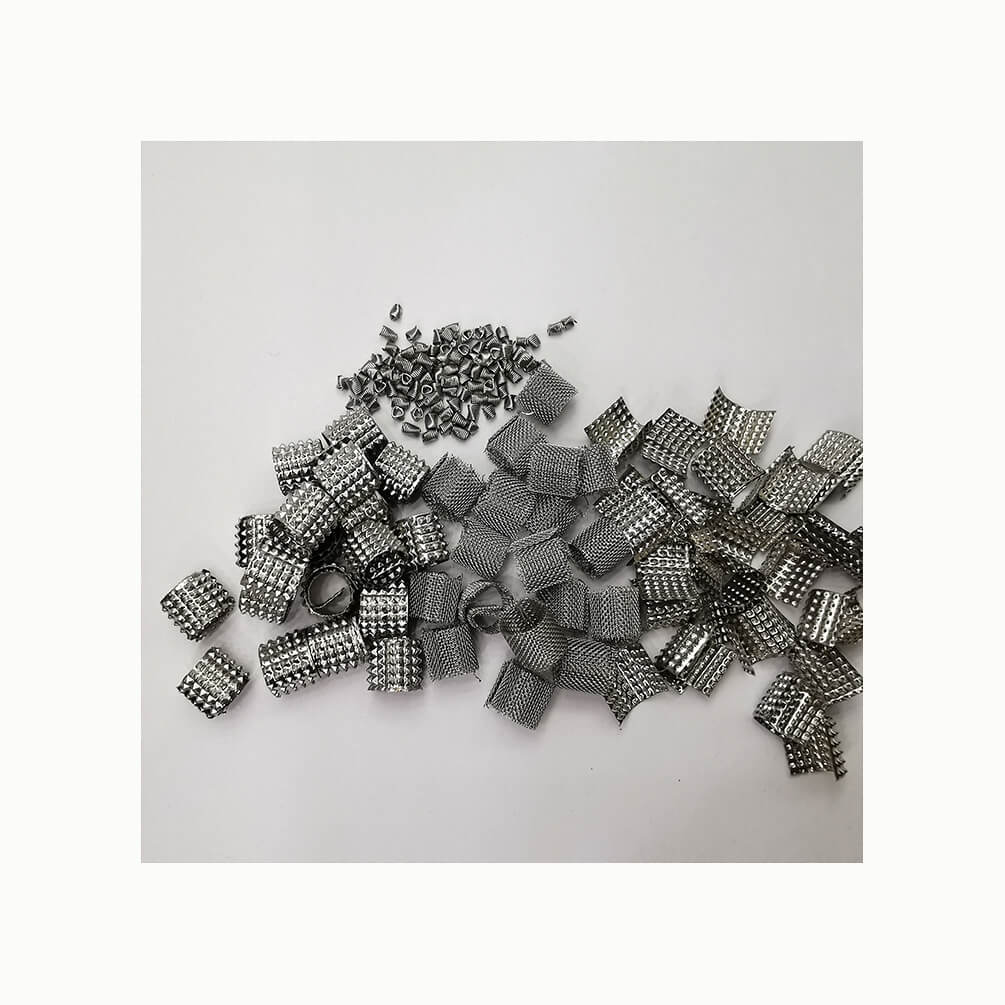Exhibition
How to Choose the Right Perforated Ceramic Ball
Perforated cera …
Zirconia Grinding Media: Stronger, Harder, Better
Zirconia cerami …
Octagonal Plastic Q-Pack: The Best Scrubber Tower Packing
“Octagonal Plas …
Anti-Fouling Heilex Ring: The Best Packing for Gas Cooling
Anti-fouling Pl …
Ss304 316L Metal Wire Mesh Dixon Ring
Elevate Your Laboratory Efficiency with Our Premium Dixon Ring
Introducing the Ss304 316L Metal Wire Mesh Dixon Ring, expertly designed for the needs of today’s laboratories. With its unparalleled durability and high-performance capabilities, this metallic laboratory column packing ring is the ideal choice for enhancing your filtration and separation processes. Made from top-grade stainless steel, these rings are engineered to deliver consistent results, ensuring your experiments yield optimal outcomes every time.
Product Description of Ss304 316L Metal Wire Mesh Dixon Ring
Dixon ring packing also known as θ ring packing is a kind of small particles and high efficient packing, it is made of metal wire with uniform diameter and height.
Application: Dixon ring packing is used mainly for laboratory and small batch, high-purity product separation process.
Unmatched Quality and Durability
Our Dixon Rings are crafted from Ss304 and 316L stainless steel, offering exceptional corrosion resistance and strength. This means they can withstand rigorous usage without compromising structural integrity. The wire mesh design provides an effective surface area that promotes optimal fluid flow, essential for your laboratory applications. Whether you are conducting chemical analysis, filtration, or extraction, these columns packing rings ensure reliable performance under various conditions.
Versatile Applications for Various Industries
These metallic laboratory column packing rings aren’t just about function; they are designed to support a wide range of applications across multiple industries. From pharmaceuticals to environmental laboratories, the Ss304 316L Metal Wire Mesh Dixon Rings are suited for any setting where quality and precision are paramount. Their versatility makes them a valuable addition to any lab toolkit, allowing researchers to adapt to different project requirements without needing to switch out packing materials.
Invest in your laboratory’s success with our premium Dixon Ring. With a focus on quality and performance, these packing rings will significantly enhance your experimental outcomes. Experience the difference in your laboratory operations today!
Technical Data Sheet of Dixon Ring (θ Ring)
Dixon Ring, it was successfully developed by British scientist O.G. Dixon in 1949 and derived from Raschig ring packing.
It is mainly used in the rectification separation process of laboratory and small batch, high-purity products, as well as the separation of stable isotopes and laboratory-scale isotope development.
It is made of 60-100 mesh metal wire mesh rolls, with the same diameter and height. Common materials include stainless steel, copper, etc. Due to the capillary action of the metal wire mesh, the liquid can be well dispersed to form a film, which is conducive to the full mass and heat transfer of gas and liquid, and can significantly eliminate instability such as channeling. Under stable operating conditions, the number of theoretical plates can reach 30 per meter, which is one of the commonly used laboratory bulk fillers in the laboratory.
Product specifications:
(diameter×height, mm) 2×2, 3×3, 4×4, 5×5, 5×5 (double layer), 6×6 (double layer), 10×10 (double layer), etc. ,
Customized specifications ≤25×25mm,
of which the most used specification is 3×3mm, and the number of theoretical plates per meter is about 20, which is much higher than structured packing.
Product Advantage
The pressure drop of packing is related with gas velocity, liquid spray quantity, material, surface tension, viscosity, the characteristics of the packing, and the flooding capacity at the same time. Dixon packing of hysteresis is higher than the similar entity packing, surface wetting condition is better than general porcelain ring too, thus its film formation rate is higher, and separation efficiency is also higher. The theoretical plate number of Dixon packing is increased with the increase of gas velocity, and at the same time, lower with reducing of the surface wetting rate of packing.
Technical Data Sheet
Specification (mm) | Net Item | Tower Diameter (mm) | Theoretical Plate (PCS/m) | Bulk Density (kg/m3) | Surface Area (m2/m3) |
Φ2×2 | 100 | Φ20-35 | 50-60 | 670 | 3500 |
Φ3×3 | 100 | Φ20-50 | 40-50 | 520 | 2275 |
Φ4×4 | 100 | Φ20-70 | 30-40 | 380 | 1525 |
Φ5×5 | 100 | Φ20-100 | 20-30 | 295 | 1180 |
Φ6×6 | 80 | Φ20-150 | 17-20 | 280 | 1127 |
Φ7×7 | 80 | Φ20-200 | 14-17 | 265 | 1095 |
Φ8×8 | 80 | Φ20-250 | 11-14 | 235 | 987 |
Φ9×9 | 80 | Φ20-300 | 8-11 | 200 | 976 |












